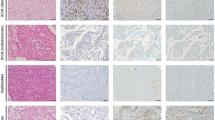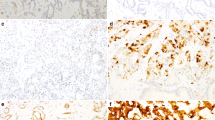Abstract
Intrahepatic cholangiocarcinoma(ICC) is a highly malignant adenocarcinoma arising from bile duct epithelial cells of the intrahepatic biliary system with early hematogenous and lymphatic extrahepatic spread. The current treatment methods for ICC are far from ideal. Identifying novel effective prognostic biomarkers which might be related to the development and progression of ICC may help provide new therapeutic strategies. Both calcium-binding protein S100A4 and Matrix metalloproteinase-9(MMP-9) are correlated with development and progression of many carcinomas. In the present study, we investigated expression of S100A4 as well as MMP-9 in ICC tissues from 65 patients using immunohistochemistry. The correlation of S100A4 and MMP-9 expression with clinicopathological features and prognosis of patients were analyzed. S100A4 and MMP-9 were positively expressed in 32(49.2 %) and 35(53.8 %) patients, respectively. The positive correlation between S100A4 and MMP-9 expression was statistically significant (P = 0.018). S100A4 positive expression was significantly correlated with vascular invasion (P = 0.008), lymph node metastasis (P = 0.029) and the TNM stage (P = 0.008). MMP-9 expression was not found to be correlated with any clinicopathological parameter. Patients with S100A4 positive expression had a significantly poorer overall survival rate than those with S100A4 negative expression (P = 0.000). MMP-9 positive expression was also correlated with poor survival (P = 0.044). However, only S100A4 expression (P = 0.004) and the surgical margin (P = 0.024) were significantly independent prognostic predictors by multivariate analysis. In conclusion, expression of S100A4 is correlated with MMP-9 expression and it could be a useful marker for predicting the progression, metastasis and prognosis of ICC.


Similar content being viewed by others
References
Rizvi S, Gores GJ (2013) Pathogenesis, diagnosis, and management of cholangiocarcinoma. Gastroenterology 145:1215–1229
Gatto M, Bragazzi MC, Semeraro R et al (2010) Cholangiocarcinoma: update and future perspectives. Dig Liver Dis 42:253–260
Khan SA, Thomas HC, Davidson BR et al (2005) Cholangiocarcinoma. Lancet 366:1303–1314
Dhanasekaran R, Hemming AW, Zendejas I et al (2013) Treatment outcomes and prognostic factors of intrahepatic cholangiocarcinoma. Oncol Rep 29:1259–1267
Nagorney DM, Kendrick ML (2006) Hepatic resection in the treatment of hilar cholangiocarcinoma. Adv Surg 40:159–171
Jarnagin WR, Shoup M (2004) Surgical management of cholangiocarcinoma. Semin Liver Dis 24:189–199
Sirica AE, Dumur CI, Campbell DJ et al (2009) Intrahepatic cholangiocarcinoma progression: prognostic factors and basic mechanisms. Clin Gastroenterol Hepatol 7:S68–S78
Mazzucchelli L (2002) Protein S100A4: too long overlooked by pathologists? Am J Pathol 160:7–13
Boye K, Maelandsmo GM (2010) S100A4 and metastasis: a small actor playing many roles. Am J Pathol 176:528–535
Huang L, Xu Y, Cai G et al (2012) Downregulation of S100A4 expression by RNA interference suppresses cell growth and invasion in human colorectal cancer cells. Oncol Rep 27:917–922
Orre LM, Panizza E, Kaminskyy VO et al (2013) S100A4 interacts with p53 in the nucleus and promotes p53 degradation. Oncogene 32:5531–5540
Jia W, Gao XJ, Zhang ZD et al (2013) S100A4 silencing suppresses proliferation, angiogenesis and invasion of thyroid cancer cells through downregulation of MMP-9 and VEGF. Eur Rev Med Pharmacol Sci 17:1495–1508
Ambartsumian N, Klingelhofer J, Grigorian M et al (2001) The metastasis-associated Mts1(S100A4) protein could act as an angiogenic factor. Oncogene 20:4685–4695
Hemandas AK, Salto-Tellez M, Maricar SH et al (2006) Metastasis-associated protein S100A4–a potential prognostic marker for colorectal cancer. J Surg Oncol 93:498–503
Ninomiya I, Ohta T, Fushida S et al (2001) Increased expression of S100A4 and its prognostic significance in esophageal squamous cell carcinoma. Int J Oncol 18:715–720
Tsukamoto N, Egawa S, Akada M et al (2013) The expression of S100A4 in human pancreatic cancer is associated with invasion. Pancreas 42:1027–1033
Matsumoto K, Irie A, Satoh T et al (2007) Expression of S100A2 and S100A4 predicts for disease progression and patient survival in bladder cancer. Urology 70:602–607
Wang YY, Ye ZY, Zhao ZS et al (2010) High-level expression of S100A4 correlates with lymph node metastasis and poor prognosis in patients with gastric cancer. Ann Surg Oncol 17:89–97
Platt-Higgins AM, Renshaw CA, West CR et al (2000) Comparison of the metastasis-inducing protein S100A4 (p9ka) with other prognostic markers in human breast cancer. Int J Cancer 89:198–208
Liu Z, Liu H, Pan H et al (2013) Clinicopathological significance of S100A4 expression in human hepatocellular carcinoma. J Int Med Res 41:457–462
Fabris L, Cadamuro M, Moserle L et al (2011) Nuclear expression of S100A4 calcium-binding protein increases cholangiocarcinoma invasiveness and metastasization. Hepatology 54:890–899
Gialeli C, Theocharis AD, Karamanos NK (2011) Roles of matrix metalloproteinases in cancer progression and their pharmacological targeting. FEBS J 278:16–27
Kessenbrock K, Plaks V, Werb Z (2010) Matrix metalloproteinases: regulators of the tumor microenvironment. Cell 141:52–67
Shirabe K, Shimada M, Kajiyama K et al (1999) Expression of matrix metalloproteinase-9 in surgically resected intrahepatic cholangiocarcinoma. Surgery 126:842–846
Zhang HY, Zheng XZ, Wang XH et al (2012) S100A4 mediated cell invasion and metastasis of esophageal squamous cell carcinoma via the regulation of MMP-2 and E-cadherin activity. Mol Biol Rep 39:199–208
Schmidt-Hansen B, Ornas D, Grigorian M et al (2004) Extracellular S100A4(mts1) stimulates invasive growth of mouse endothelial cells and modulates MMP-13 matrix metalloproteinase activity. Oncogene 23:5487–5495
Bjornland K, Winberg JO, Odegaard OT et al (1999) S100A4 involvement in metastasis: deregulation of matrix metalloproteinases and tissue inhibitors of matrix metalloproteinases in osteosarcoma cells transfected with an anti-S100A4 ribozyme. Cancer Res 59:4702–4708
Zhang G, Li M, Jin J et al (2011) Knockdown of S100A4 decreases tumorigenesis and metastasis in osteosarcoma cells by repression of matrix metalloproteinase-9. Asian Pac J Cancer Prev 12:2075–2080
Saleem M, Kweon MH, Johnson JJ et al (2006) S100A4 accelerates tumorigenesis and invasion of human prostate cancer through the transcriptional regulation of matrix metalloproteinase 9. Proc Natl Acad Sci U S A 103:14825–14830
Nakanuma Y, Sripa B, Vatanasapt V et al (2000) Intrahepatic cholangiocarcinoma. In: Hamilton SR, Aaltonen LA (eds) World health organization classification of tumours: pathology and genetics of tumours of the digestive system. IARC Press, Lyon, pp 173–180
Cardinale V, Semeraro R, Torrice A et al (2010) Intra-hepatic and extra-hepatic cholangiocarcinoma: new insight into epidemiology and risk factors. World J Gastrointest Oncol 2:407–416
Schmidt-Hansen B, Klingelhofer J, Grum-Schwensen B et al (2004) Functional significance of metastasis-inducing S100A4(Mts1) in tumor-stroma interplay. J Biol Chem 279:24498–24504
Sato Y, Harada K, Sasaki M et al (2013) Clinicopathological significance of S100 protein expression in cholangiocarcinoma. J Gastroenterol Hepatol 28:1422–1429
Shibahara H, Tamada S, Higashi M et al (2004) MUC4 is a novel prognostic factor of intrahepatic cholangiocarcinoma-mass forming type. Hepatology 39:220–229
Sotiropoulos GC, Miyazaki M, Konstadoulakis MM et al (2010) Multicentric evaluation of a clinical and prognostic scoring system predictive of survival after resection of intrahepatic cholangiocarcinoma. Liver Int 30:996–1002
Acknowledgments
We are grateful to Professor Qiangxiu Wang (Department of Pathology, Provincial Hospital Affiliated to Shandong University, Jinan, China) and Yongsheng Gao (Department of Pathology, Shandong Tumor Hospital, Jinan, China) for evaluating the immunostained sections. Thanks to Dr. Edward C. Mignot, Shandong University, for linguistic advice. A portion of this study was supported by a grant from The Natural Science Foundation of Shandong Province (No.2007ZRB14001).
Author information
Authors and Affiliations
Corresponding author
Rights and permissions
About this article
Cite this article
Tian, X., Wang, Q., Li, Y. et al. The Expression of S100A4 Protein in Human Intrahepatic Cholangiocarcinoma: Clinicopathologic Significance and Prognostic Value. Pathol. Oncol. Res. 21, 195–201 (2015). https://doi.org/10.1007/s12253-014-9806-6
Received:
Accepted:
Published:
Issue Date:
DOI: https://doi.org/10.1007/s12253-014-9806-6




